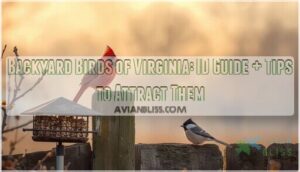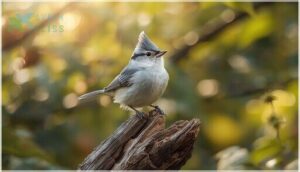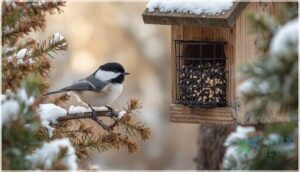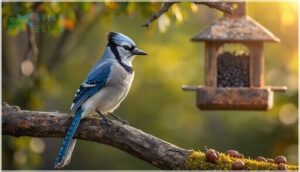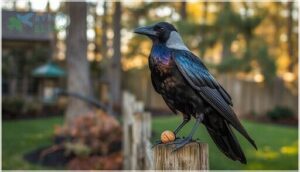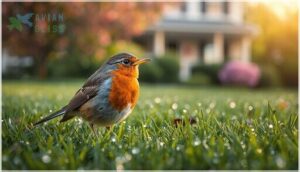This site is supported by our readers. We may earn a commission, at no cost to you, if you purchase through links.
A male Northern Cardinal lands on your fence post, his crimson feathers catching the morning light like a living ember against Virginia’s gray January sky. Within seconds, a Carolina Chickadee zips past to investigate your suet feeder while a Tufted Titmouse announces its arrival with a sharp whistle.
Virginia’s geographical position—straddling the Piedmont, Coastal Plain, and Appalachian regions—creates a remarkable crossroads where southern residents like cardinals mix with northern visitors, making your backyard a surprisingly diverse stage for avian activity.
Over 470 bird species have been documented across the Commonwealth, and roughly 30 to 40 of these regularly visit residential feeders and gardens throughout the year. Learning to identify these backyard birds of Virginia transforms your morning coffee routine into an ongoing natural history lesson, revealing behavioral patterns, seasonal shifts, and conservation stories unfolding just beyond your window.
Table Of Contents
- Key Takeaways
- Common Backyard Birds in Virginia
- Identifying Backyard Birds
- Birds of Prey and Waterbirds Seen in Yards
- Attracting Birds to Your Virginia Yard
- Seasonal and Conservation Considerations
- Frequently Asked Questions (FAQs)
- What are the most common backyard birds in Virginia?
- Where can you see birds in Virginia?
- Do you see birds at feeders or backyards in Virginia?
- Which bird feeder attracts the most birds in Virginia?
- Where can I See Birds in Virginia?
- How can I identify a bird in my yard?
- What bird is Virginia known for?
- Is it good to have birds in your backyard?
- What is the rarest bird in Virginia?
- What are the most common birds in Virginia?
- Conclusion
Key Takeaways
- Virginia’s unique position straddling the Piedmont, Coastal Plain, and Appalachian regions creates a remarkable crossroads where over 470 documented bird species mix, with 30-40 regularly visiting residential feeders year-round.
- Identifying backyard birds relies on observing four key features—size and body proportions, bill shape and color, plumage patterns including sexual dimorphism and seasonal molting, and behavioral habits tied to specific habitat preferences.
- Creating effective bird habitat requires layering multiple elements: offering diverse feeder types with species-specific seeds, providing fresh water sources, installing properly sized and positioned nest boxes, and planting native vegetation like serviceberry and Virginia sweetspire that deliver year-round food and cover.
- Several Virginia backyard species face conservation challenges from habitat fragmentation and urban sprawl, which reduce nesting sites by up to 40% and increase predation risk by 15-20%, making yard-scale restoration efforts and native plantings critical for supporting declining populations.
Common Backyard Birds in Virginia
Virginia’s backyards attract a diverse mix of resident and seasonal birds that you’ll spot year-round or during specific times of the year. From the bright red flash of a cardinal to the cheerful song of a Carolina wren, these ten species represent the most common visitors you’re likely to see at your feeders and in your trees.
Let’s look at each bird’s distinctive features, preferred habitats, and what makes them special in the Virginia landscape.
Northern Cardinal
The Northern Cardinal (Cardinalis cardinalis) is Virginia’s most recognizable backyard bird, with males sporting vibrant red plumage and females displaying brownish-red feathers. You’ll spot these 8.5-inch songbirds year-round in shrubby edges and suburban yards, where their sharp chirps and whistles echo from elevated perches. Cardinals love sunflower seeds at bird feeders and defend territories fiercely during breeding season.
Understanding the importance of clear science information is essential for writing research papers.
Tufted Titmouse
While cardinals steal the spotlight, you’ll find Tufted Titmouse (Baeolophus bicolor) bringing just as much personality to your Virginia backyard. This 5.5-inch dynamo sports a bluish-gray crest and pale face, bouncing through feeders with fearless energy. Listen for its “peter-peter-peter” whistle echoing from deciduous trees. You’ll see its feather patterns—plain gray above, lighter below—as it cracks seeds with that stout bill and tucks into tree cavities come nesting season.
Understanding the importance of research methodology approaches can help in identifying and studying bird species.
Carolina Chickadee
Just as bold but smaller, the Carolina Chickadee (Poecile carolinensis) measures 4.7–5.5 inches with its black cap and bib marking every Virginia backyard. You’ll spot these curious acrobats year-round, their “chick-a-dee-dee-dee” call signaling their approach to your feeders. They cache sunflower seeds in winter, defend small territories, and nest in cavities lined with moss.
Chickadee Behavior highlights:
- Bold approach at bird feeders, often feeding in mixed-species flocks
- Cache food during winter months for later retrieval
- Defend small foraging territories throughout the year
Bird Feeder Tips for attracting them:
- Offer black oil sunflower seeds and suet, especially in winter
- Provide nest boxes with proper predator guards for breeding success
- Add native shrubs and deciduous trees to boost natural insect prey
Garden Attractants that work:
- Install accessible birdbaths for hydration during dry periods
- Plant native vegetation to support overall avian diversity
- Maintain clean feeders to reduce disease transmission among songbirds
Blue Jay
You’ll recognize the Blue Jay (Cyanocitta cristata) by its striking bright blue upperparts, white chest, and bold black bib stretching 9–11 inches. Feather Coloration and that distinctive crest make Bird Identification easy in Virginia backyards.
Blue Jay Behavior includes loud “jay” calls and Bird Caching habits—they stash acorns for winter. Jay Socialization happens in mixed flocks, while Jay Migration varies by region.
Attract them with sunflower seeds in Bird Feeders near oak trees.
American Crow
You’ll spot the American Crow (Corvus brachyrhynchos) by its glossy black plumage, heavy bill, and 16–21 inch wingspan—a smart operator in Virginia’s backyard ecosystem.
Crow Behavior includes complex Social Learning and impressive Foraging Strategies, from cracking nuts on pavement to tool use.
Their Urban Adaptation shines through communal roosts and family-based Nesting Habits in tall pines, making Bird Identification straightforward for Bird Watching enthusiasts tracking Backyard Birds.
Carolina Wren
You’ll hear the Carolina Wren (Thryothrix ludovicianus) before you spot it—a bold, tea-kettle song announcing its presence in your Virginia Backyard Habitat. This 4-6 inch insectivore sports warm rusty-brown plumage with a signature white eyebrow stripe, making Bird Identification straightforward.
Wren Behavior includes Wren Nesting in dense shrubs near Bird Feeders, while their Wren Diet shifts from insects to berries seasonally among Backyard Birds.
Mourning Dove
The Mourning Dove (Zenaida macroura) glides into your Virginia yard with a slender 9–11 inch body and soft tan plumage—a year-round resident of suburban spaces. Backyard Birds enthusiasts appreciate its gentle presence near Bird Feeders, where Bird Seed Preferences include millet and cracked corn scattered on ground platforms.
Recognizing this dove:
- Grayish-brown Feather Characteristics with white-tipped tail feathers visible during flight
- Mournful cooing calls that echo through neighborhoods during Nesting Behaviors season
- Ground-foraging patterns showing Dove Migration Patterns—mostly sedentary with local winter movements
Bird Identification becomes simple once you notice their distinctive whistling wingbeats.
American Robin
You’ll spot the American Robin (Turdus migratorius) hopping across your Virginia lawn year-round, its 9–11 inch frame sporting that iconic orange-red breast. Robin Migration brings seasonal shifts—southern populations stay put while northern birds arrive during spring.
Robin Behavior includes vigorous ground-foraging for earthworms, making Bird Identification easy. Their Nesting Habits favor trees near homes, and these Urban Birds rarely visit Bird Feeders, preferring natural food sources instead.
American Goldfinch
The American Goldfinch (Spinus tristis) is a late-summer standout in Virginia Backyard Birds—males turn vivid yellow during breeding season before feather molting shifts them to dull olive-brown for winter. Goldfinch migration brings flocks to your yard year-round, and their soft trill song patterns announce their arrival.
- Their seed preferences lean heavily toward nyjer and sunflower seeds at tube feeders
- Nesting habits occur surprisingly late, often July through September when thistle seeds mature
- Gardening for birds with native sunflowers and asters aids their natural foraging, making bird identification easier when you recognize their bouncing flight
Chipping Sparrow
The Chipping Sparrow (Spizella passerina) is one of Virginia’s most approachable backyard birds, measuring just 5.5 to 6.3 inches long with a distinctive rufous crown stripe that makes bird identification straightforward during breeding season.
You’ll notice their feather patterns shift subtly between seasons as bird migration brings them north each spring. Their sparrow habitat includes suburban yards with short grass, where nesting behavior involves building cup-shaped nests in shrubs, and backyard birding enthusiasts often recognize this bird species by its sharp, metallic chip calls.
Identifying Backyard Birds
Watching birds in your yard gets a lot more rewarding once you know what you’re looking at. The trick is learning which details actually matter when you’re trying to tell one species from another.
Here are the key features to focus on when identifying the birds that visit your Virginia backyard.
Size and Shape
When you’re watching backyard birds in Virginia, body proportions tell you everything. A Northern Cardinal’s sturdy 8.3–9.5 inch frame looks totally different from a Carolina Chickadee’s tiny 4.7–5.5 inch body.
Wing span, tail sizes, and feather length create distinct silhouettes that make bird identification easier. Notice how Blue Jays stretch 9–12 inches while American Crows dominate at 16–21 inches—size matters in backyard birding.
Bill Type and Color
Bill shapes reveal how Virginia birds make their living. Northern Cardinals wield stout, hooked beaks perfect for cracking seeds, while Downy Woodpeckers sport chisel-shaped bills for excavating insects. American Robins flash yellow beaks against rusty breasts, and Blue Jays show pale grayish bills.
Beak colors shift with molt cycles and breeding season—notice how goldfinches brighten in spring. These adaptations and feather patterns enable instant identification.
Plumage Color and Pattern
Beyond beak structure, plumage tells the full story of identification. Look for these key markers:
- Sexual dimorphism: Male Northern Cardinals flash vivid red while females wear brownish tones with crimson highlights.
- Iridescence Effects: Blue Jays and Redbellied Woodpeckers reveal shifting sheens as light angles change.
- Molting Cycles: American Robins grow warmer breast feathers in spring, while goldfinches transform from olive-gray to lemon-yellow.
- Feather Texture: Pattern Recognition sharpens with Downy Woodpecker’s bold black-and-white ladder backs versus subtle Color Variance in Carolina Wrens’ rufous flanks.
Behavior and Habitat
Once you’ve noted plumage details, watch how birds move and where they hang out. Cardinals stick to shrubby edges year-round, while chickadees dart between bark crevices hunting insects. Robins switch from lawns in spring to berry patches by fall.
Habitat modification through native plantings boosts foraging strategies, and understanding nesting preferences helps you recognize breeding behavior in Virginia’s backyard birds.
| Species | Primary Habitat | Foraging Strategy |
|---|---|---|
| Northern Cardinal | Dense shrub cover | Ground-level seed picking |
| Tufted Titmouse | Deciduous woods | Bark and foliage gleaning |
| American Robin | Open lawns to fruit trees | Insect hunting to fruit eating |
Using Field Guides and Apps
You’ll want a solid field guide—Peterson or National Geographic both map Virginia-specific ranges—paired with birding software like Merlin Bird ID for quick species identification.
eBird tracks your backyard birds over time and shows seasonal abundance at local hot spots. Cross-check visuals, calls, and behaviors in both resources to nail down tricky species and sharpen your bird identification skills across Virginia’s diverse habitats.
Birds of Prey and Waterbirds Seen in Yards
You mightn’t expect hawks, eagles, or herons in your backyard, but Virginia’s diverse habitats bring these impressive birds closer than you’d think. Larger yards near water, fields, or wooded areas attract raptors hunting for prey and waterbirds seeking fish or insects.
Here are the birds of prey and waterbirds you’re most likely to spot from your own property.
Red-tailed Hawk
You might spot a Red-tailed Hawk (Buteo jamaicensis) soaring overhead on broad wings, scanning Virginia fields and woodland edges for prey. This sturdy raptor with its signature brick-red tail is a year-round resident, nesting in tall trees from March through July.
Hawk migration brings northern populations through in fall, boosting backyard bird sightings. Watch for dark wrist patches and that rasping scream during raptor research outings—they’re protecting territory in hawk habitat across our state.
American Kestrel
You’ll notice the American Kestrel (Falco sparverius), a small, colorful falcon, perched on roadside poles scanning Virginia croplands and grasslands for rodents and insects.
This backyard bird species establishes falcon habitat in tree cavities from March through July, with kestrel behavior showing both year-round residents and migrants.
Kestrel migration patterns shift with prey availability, making hawk conservation and protecting bird nesting sites essential for supporting wildlife conservation in Virginia during your bird watching adventures.
Bald Eagle
You might spot the Bald Eagle (Haliaeetus leucocephalus) soaring over Virginia rivers and reservoirs, with its seven-foot wingspan and distinctive white head marking backyard bird encounters near water. Eagle nesting occurs in massive stick structures along the Chesapeake Bay, where habitat protection and bird conservation efforts have boosted populations since the 1990s.
Feather identification reveals dark brown bodies contrasting with white tails during eagle migration and year-round residency across bird species in Virginia, making wildlife conservation in Virginia and bird watching in Virginia truly remarkable.
Osprey
You’ll recognize the Osprey (Pandion haliaetus) hovering over Virginia’s tidal rivers before plunging feet-first for fish 10 to 30 centimeters long. Osprey nesting thrives along coastal habitats like the Chesapeake Bay, where 8,000 to 10,000 breeding pairs raise young on platforms and dead trees from April through September.
Despite strong breeding patterns historically, conservation status concerns have emerged as wildlife conservation experts document declining productivity in higher-salinity waters affecting bird species in Virginia during backyard bird encounters and bird watching in Virginia expeditions focused on fish diet specialists.
Barn Owl and Great Horned Owl
Two nocturnal hunting specialists—the Barn Owl (Tyto alba) with its heart-shaped facial disk and eerie screech, and the Great Horned Owl (Bubo virginianus) with ear tufts and deep hooting—patrol Virginia backyards after dark.
You’ll distinguish these bird species by their distinct vocalizations and nighttime behavior, both contributing to wildlife conservation through rodent control while demonstrating fascinating nesting patterns in tree cavities and building structures.
Canada Goose
Large flocks of Canada Geese (Branta canadensis) graze across Virginia lawns and agricultural fields, particularly during fall and spring migration patterns along the Atlantic Flyway. You’ll identify this bird species by its six-to-seven-foot wingspan, distinctive black head, and white chinstrap—key feather identification markers.
Their grazing behavior disturbs ground vegetation, so Virginia wildlife habitat management guidelines recommend observing from a distance rather than supplemental feeding to minimize flocking dynamics conflicts in backyard bird environments.
Mallard
You’ll spot Mallards (Anas platyrhynchos) dabbling in shallow backyard ponds or suburban retention basins across Virginia wildlife habitats year-round. Males flash glossy green heads and chestnut breasts during breeding season—essential feather identification markers—while females wear mottled brown plumage.
Mallard migration patterns peak during fall and spring when northern populations join resident pairs. Their waterfowl diet shifts seasonally between aquatic plants and invertebrates, supporting backyard birding tips focused on natural duck habitat preservation over supplemental feeding for bird conservation.
Great Blue Heron
You might notice a Great Blue Heron (Ardea herodias) stalking through shallow backyard wetlands or perched near your pond in Virginia wildlife zones. This blue-gray waterbird conservation priority stands 36 to 56 inches tall with a 66 to 79-inch wingspan, and you’ll recognize its S-curved neck during flight.
Heron behavior includes patient stalk-and-pounce hunting for fish and amphibians, while heron migration patterns bring both resident and seasonal visitors to heron habitat throughout Virginia.
Wood Duck
While herons wade through shallows, you’ll find Wood Ducks (Aix sponsa) nesting in cavities near backyard ponds and wetlands—a unique waterfowl conservation priority in Virginia. Males show off glossy green heads and iridescent chestnut breasts during duck migration season from March to June, while females sport mottled brown plumage for feather identification.
- They nest in old snags or nest boxes you provide
- Their diet includes acorns, seeds, and duckweed
- Nesting behavior peaks in late spring breeding season
- Wood duck habitat requires water access and cavity trees for wildlife gardening success
Attracting Birds to Your Virginia Yard
Turning your Virginia yard into a bird haven doesn’t require fancy equipment or a degree in ornithology. You just need to understand what birds are looking for: food, water, shelter, and safe places to raise their young.
Let’s break down the key strategies that’ll have Northern Cardinals, Blue Jays, and dozens of other species making your backyard their regular hangout.
Bird Feeders and Types
You’ll attract more backyard birds with the right feeder setup. Platform feeders draw cardinals and jays with black oil sunflower seed selection, while tube feeders minimize spillage for chickadees and finches. Suet options provide high-energy protein for woodpeckers during winter months.
Proper feeder placement in shrubby areas and regular feeder maintenance prevent mold growth, keeping your bird-friendly space healthy and inviting for diverse species throughout Virginia’s seasons.
Offering Water Sources
Beyond feeders, you’ll notice birds flock to reliable water sources for drinking and bathing year-round. Virginia’s backyard birds need fresh water daily, making birdbath maintenance essential for wildlife-friendly landscaping success.
- Position shallow birdbaths 10-15 feet from shrubs where predators hide
- Install fountain systems with moving water to attract warblers and thrushes
- Use rain barrel usage overflow for natural pond installation projects
- Clean water features weekly preventing algae and disease transmission
- Add stones creating depth variation for different bird species sizes
Providing Birdhouses and Nesting Sites
You can boost Virginia’s backyard birds by installing birdhouses 5 to 15 feet high with entry holes matching your target species—1⅛ inches for Carolina Chickadees and Wrens, 1½ inches for Eastern Bluebirds.
Position nesting boxes facing away from prevailing winds with morning sun exposure, spacing them 15 to 25 feet apart.
Accessible cleanout lids enable annual maintenance, reducing parasites while supporting bird conservation through proper site selection and predator control measures.
Planting Native Plants and Shrubs
You create year-round habitat for Backyard Birds in Virginia by choosing Native Plants that deliver food, cover, and nesting sites. Soil Preparation matters—test pH and drainage before installing Bird Friendly Shrubs like arrowwood viburnum (Viburnum dentatum) or American holly (Ilex opaca). Work with Local Nursery Sources to confirm genetic provenance, then layer evergreen and deciduous species for seasonal structure. Garden Maintenance and thoughtful Gardening for Birds and Wildlife complete your Bird Friendly Plants strategy.
- Serviceberry (Amelanchier arborea) provides early-spring flowers and edible berries for thrushes and songbirds.
- Virginia sweetspire (Itea virginica) offers dense cover, nectar, and vibrant fall color in moist soils.
- Little bluestem (Schizachyrium scoparium) forms seed-rich clumps that feed finches and sparrows.
- Red maple (Acer rubrum) sustains insect life critical for nestling food and tolerates varied moisture.
- *Blueberry varieties (Vaccinium spp.
*)** deliver fruit for birds and require acidic, well-drained soils.
Creating Shelter and Safe Spaces
You protect Backyard Birds in Virginia by layering Shelter Design from the ground up. Install brush piles and dense evergreen shrubs for Wildlife Protection, then position nesting boxes with predator guards to secure Nesting Sites.
Bird Safety improves when you reduce nighttime lighting and establish buffer zones during breeding season.
This Habitat Creation approach fosters Wildlife Friendly Landscaping, blending Gardening for Birds and Wildlife with practical Bird Conservation and Education.
Seasonal and Conservation Considerations
Your Virginia backyard isn’t just a snapshot in time—it’s a living stage where different birds come and go with the seasons, and some species need your help more than ever. Understanding when migrants pass through, which residents stay year-round, and what threats they face helps you become a better steward of your local bird community.
Here’s what you need to know about seasonal patterns, conservation challenges, and how you can make a real difference right in your own yard.
Winter and Summer Bird Visitors
Your Virginia backyard transforms with the seasons, hosting different birds year-round. Winter visitors like Northern Cardinal, Blue Jay, and Tufted Titmouse cluster at feeders during cold snaps, while American Robin populations shift inland.
Summer residents include breeding warblers and thrushes passing through. Seasonal feeding patterns change too—winter brings seed-eaters seeking food sources, while summer residents hunt insects.
Bird activity peaks at dawn and dusk, especially during bird migration periods.
Migration Patterns in Virginia
You’ll notice dramatic seasonal shifts as birds follow the Atlantic Flyway through Virginia. Spring migration peaks in April and May when warblers and thrushes move north, while fall brings southbound travelers from August through October.
Regional variations matter—Piedmont areas see earlier spring arrivals than coastal zones, and mountain counties experience delayed migration timing due to cooler temperatures and extended snow cover.
Species of Conservation Concern
Some birds you’re spotting need your attention right now. The Virginia Department of Wildlife Resources tracks Species of Greatest Conservation Need (SGCN) that include backyard visitors facing population declines. Bird monitoring programs and habitat preservation efforts rely on your observations to guide species protection strategies and wildlife management decisions across the state.
- Northern Bobwhites have lost over 80% of their population due to shrubby habitat conversion and fragmentation
- Red Knots face critical conservation status from coastal development disrupting their migration stopover sites
- American Golden-Plovers depend on grassland corridors that continue shrinking throughout Virginia’s agricultural regions
- Wood Thrushes need forest interior conditions that suburban sprawl steadily eliminates from their breeding territories
- Prothonotary Warblers require swamp forests and bottomland hardwoods threatened by drainage and water quality decline
Effects of Habitat Loss
When developers clear land, you lose more than scenery. Habitat fragmentation in Virginia reduces nesting sites for songbirds by up to 40%, directly lowering reproduction rates in your neighborhood.
Urban sprawl increases predation risk by 15–20% through edge effects, while native vegetation loss shifts diets from insects to seeds, cutting juvenile survival by 10–25% in winter.
Ecosystem disruption from environmental degradation reshapes the backyard birds you see daily.
Supporting Bird Conservation Locally
You can fight habitat loss right in your neighborhood. Partner with local Audubon chapters to launch yard-scale habitat restoration projects, or join community bird surveys that document species trends.
Advocate for bird-friendly policies like window collision prevention and native plantings in public spaces.
Urban wildlife management starts at home—install native shrubs, reduce pesticides, and engage neighbors in backyard birds conservation that connects fragmented green spaces across Virginia.
Urban wildlife management starts at home through native plantings, pesticide reduction, and neighbors working together to restore fragmented green spaces
Frequently Asked Questions (FAQs)
What are the most common backyard birds in Virginia?
Virginia backyards buzz with feathered friends year-round. You’ll spot Northern Cardinals, Tufted Titmice, Carolina Chickadees, Blue Jays, and American Robins most frequently—these Common Backyard Birds thrive in Virginia’s diverse habitats and eagerly visit feeders.
Where can you see birds in Virginia?
You’ll spot abundant species along coastal birding trails, wetland areas, and mountain trails throughout Virginia. Urban parks and nature reserves in Virginia provide reliable viewing year-round, while rural landscapes host diverse residents and migrants.
Do you see birds at feeders or backyards in Virginia?
You’ll absolutely see birds at feeders and Virginia backyards—like clockwork. Northern Cardinals, Tufted Titmice, Carolina Chickadees, and Blue Jays rank among the most frequent visitors, especially when seed feeders or suet are available year-round.
Which bird feeder attracts the most birds in Virginia?
Black-oil sunflower seed feeders attract the most birds in Virginia backyards, drawing cardinals, chickadees, titmice, and finches.
Pair them with water features and proper feeder placement near cover to boost bird diversity year-round.
Where can I See Birds in Virginia?
You’ll find the best bird watching where you least expect it—National Refuges, Coastal Areas, Mountain Trails, Urban Parks, and Wetland Habitats across Virginia all offer stunning encounters with Backyard Birds and rare species alike.
How can I identify a bird in my yard?
You’ll master bird identification by studying beak shapes, feather patterns, and wing colors. Notice tail features and bird silhouettes against the sky. These visual cues quickly reveal which Virginia bird species you’re watching.
What bird is Virginia known for?
Virginia’s state bird symbol is the Northern Cardinal, adopted in
You’ll spot this wildlife emblem year-round in backyards across Virginia—its bright red plumage and cheerful song make it instantly recognizable.
Is it good to have birds in your backyard?
You’ll get free pest control, pollination help, and a front-row seat to Virginia’s wildlife show.
Backyard birds boost ecosystem health while teaching families about conservation—plus, bird watching beats doomscrolling any day.
What is the rarest bird in Virginia?
The Ivory-billed Woodpecker stands as the rarest Virginia bird species, though sightings remain highly disputed.
Red-cockaded Woodpeckers have extremely limited southeastern populations, while Snowy Owls appear episodically during unusual winter irruptions.
What are the most common birds in Virginia?
Like a gathering of familiar neighbors at the local diner, certain feathered faces show up reliably across the Commonwealth. Northern Cardinals, Tufted Titmice, Carolina Chickadees, Blue Jays, and American Crows dominate Virginia’s songbirds.
Conclusion
That cardinal at your feeder represents something bigger than a splash of red against winter branches—it’s your front-row seat to conservation in action.
Every native shrub you plant, every feeder you fill, and every identification you make strengthens the invisible threads connecting backyard birds of Virginia to thriving ecosystems.
Your yard isn’t just property; it’s habitat. And the knowledge you’ve gained here transforms you from observer into steward of the avian crossroads unfolding outside your window.

